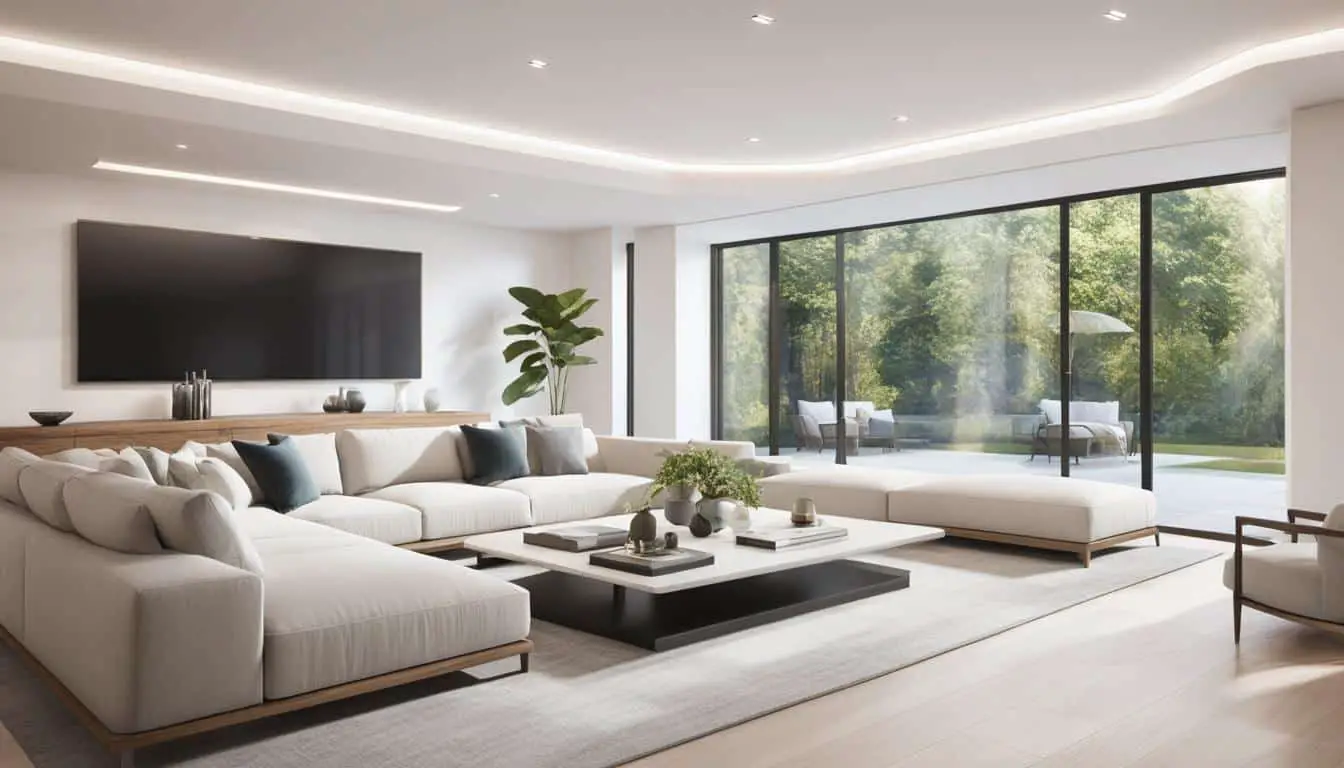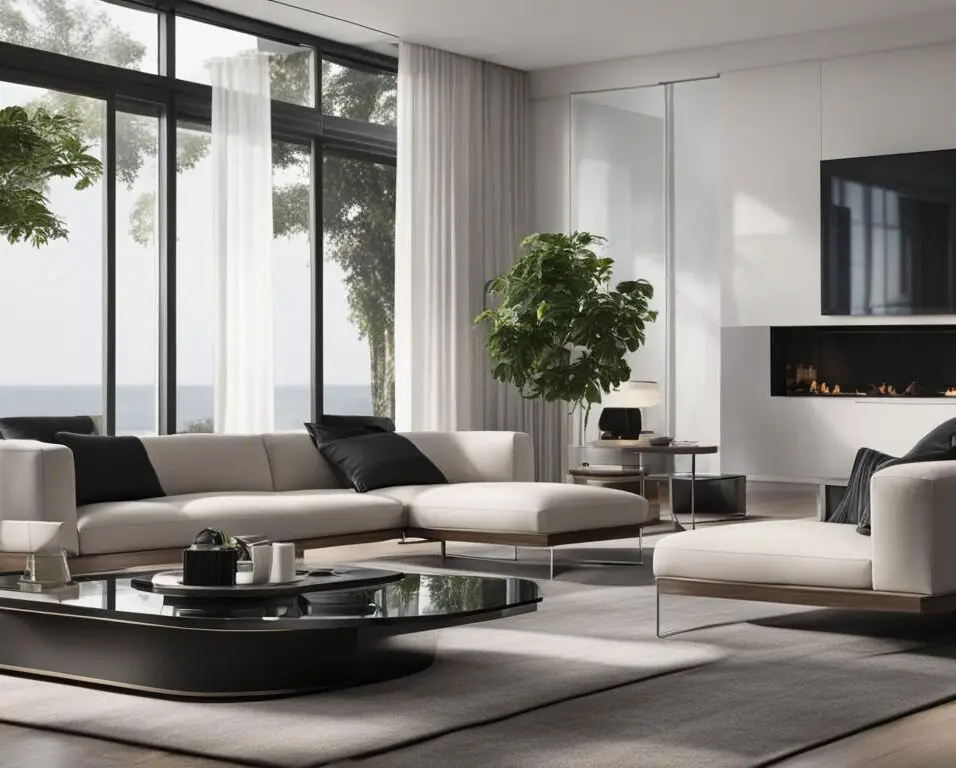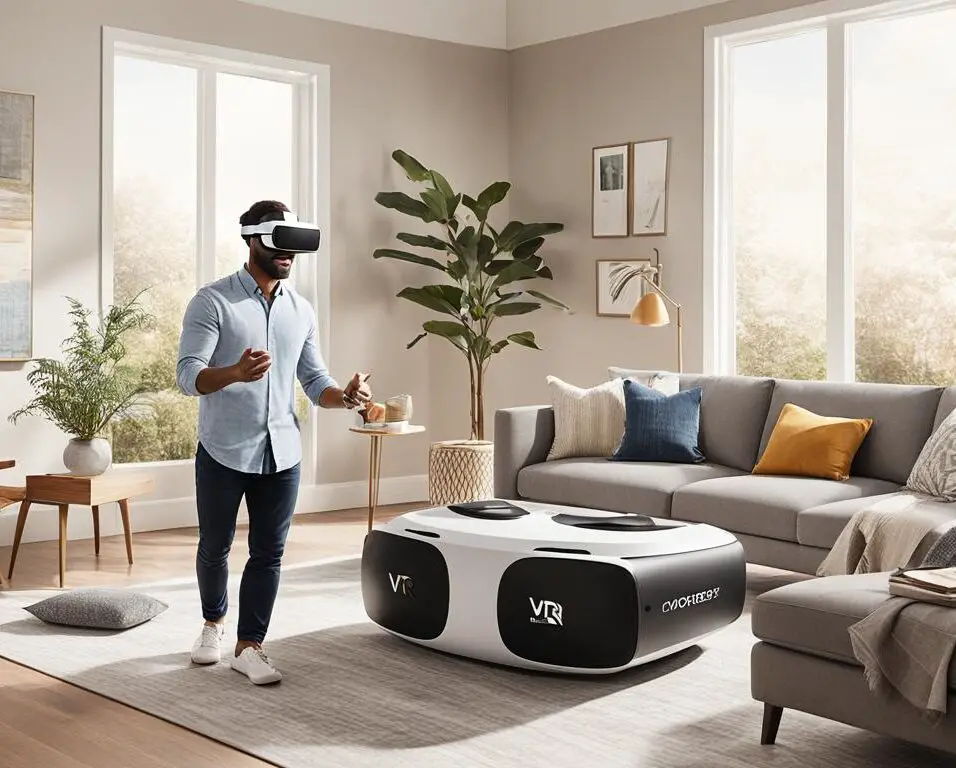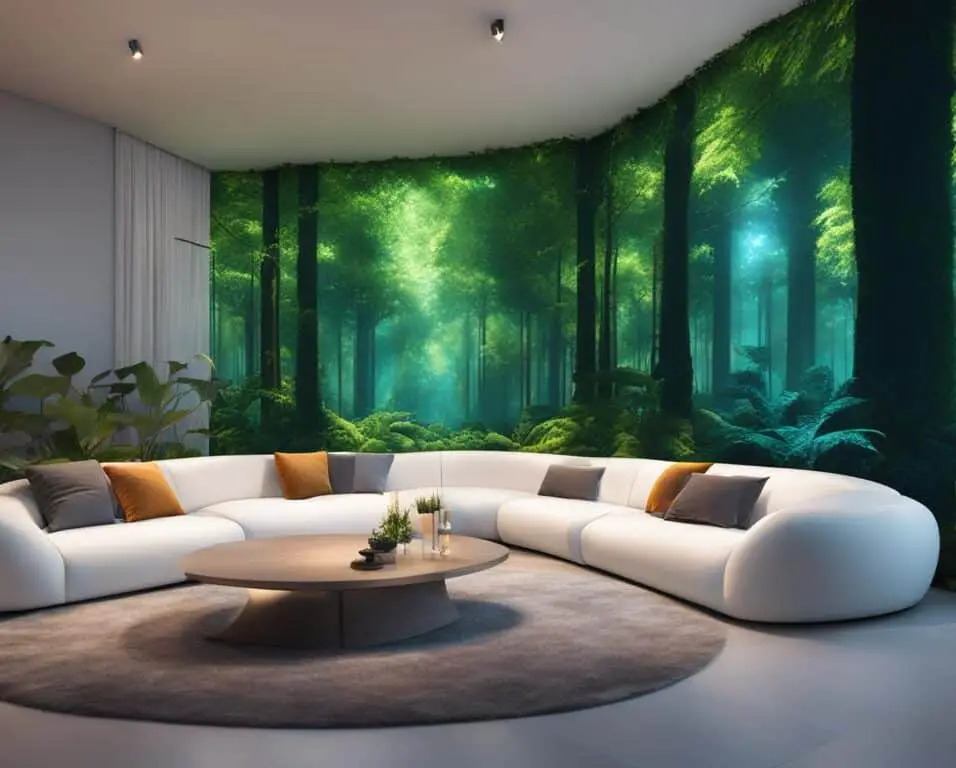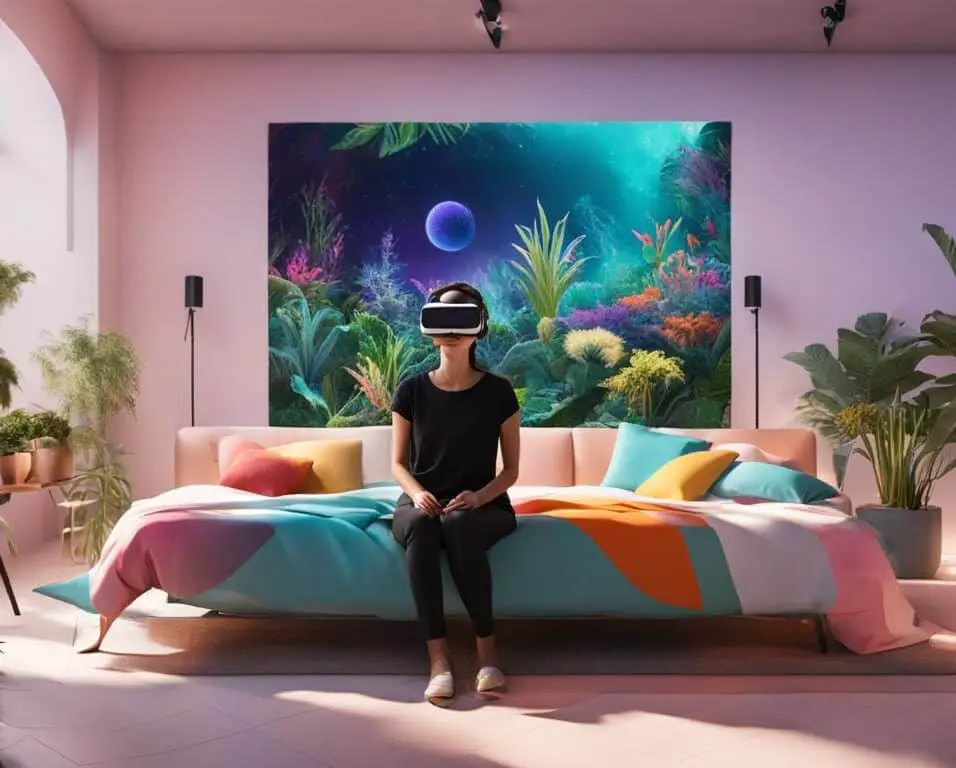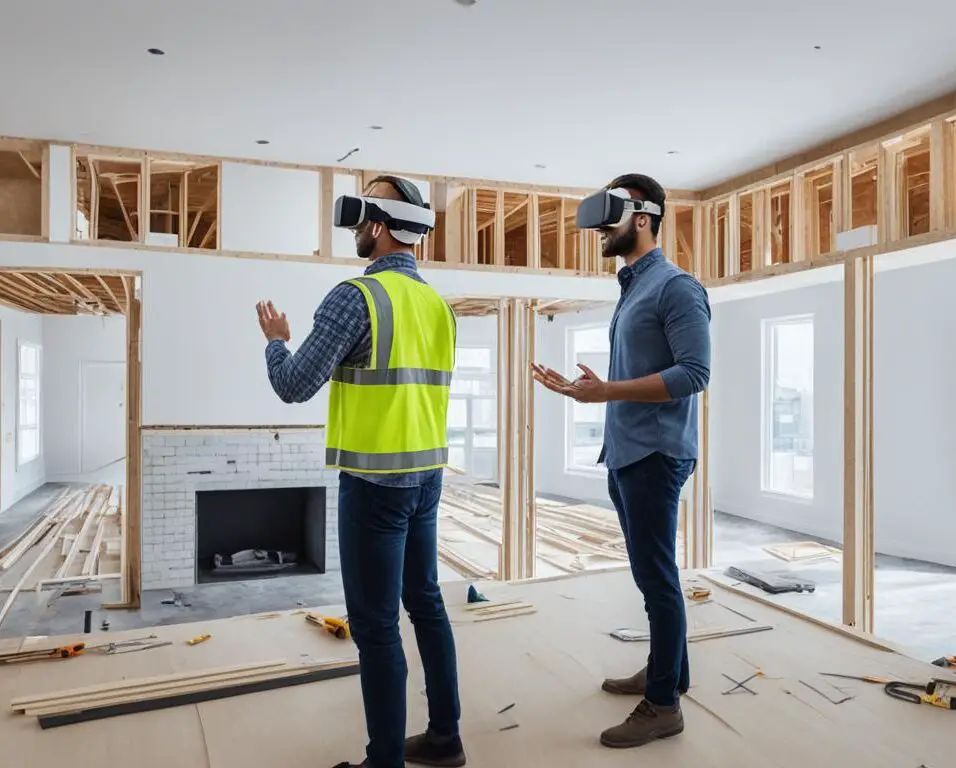VR in Future Residential Architecture Trends
VR technology is revolutionizing the future of home design and shaping residential architecture trends. With the ability to create realistic virtual environments, architects and designers can now visualize and present their ideas in a more immersive and interactive way. This technology has the potential to transform how we envision living spaces and create new opportunities for innovation in the field of residential architecture.
Key Takeaways:
- VR technology is changing the game for residential architecture by offering immersive and interactive visualizations.
- Architects and designers can use VR to create realistic virtual environments and present their ideas effectively.
- VR allows clients to experience and understand the design concept before construction, helping to identify any flaws or improvements.
- Virtual reality offers time and cost savings by eliminating the need for physical prototypes and enabling quick design iterations.
- VR has numerous applications in residential architecture, from interior design to urban planning and sustainable building design.
The Benefits of VR in Residential Architecture
Virtual reality (VR) has revolutionized the way architects and clients envision and interact with residential architecture. The advancements in VR technology have brought numerous benefits to the design process, enhancing communication, understanding, and efficiency. In this section, we will explore the benefits of VR in residential architecture, highlighting how it enables visualization, immersive experiences, and cost savings.
Visualization of Design Concepts
One of the key benefits of VR in residential architecture is the ability to visualize and experience the design before it is built. VR technology allows architects and clients to step into a virtual representation of the space, providing a realistic and immersive experience. This enables all stakeholders to understand the design concept more intuitively, facilitating clear communication and avoiding any misinterpretations. By visualizing the design in VR, architects and clients can identify potential design flaws or improvements early on in the process, ensuring that the final product meets the desired specifications.
Immersive and Realistic Experiences
VR offers a level of immersion and realism that cannot be achieved through traditional design presentations. By using VR headsets, users can explore and interact with virtual environments, experiencing the space from different perspectives. This enables clients to fully understand and appreciate the design concept, as they can virtually walk through the rooms, view the proportions, and get a sense of the overall atmosphere. The immersive nature of VR helps clients make informed decisions and creates a stronger emotional connection to the design, leading to higher satisfaction levels.
Time and Cost Savings
Implementing VR in the design process can result in significant time and cost savings. Traditionally, architects would need to create physical prototypes or scale models to present the design to clients. This process can be time-consuming and expensive, especially when modifications or iterations are required. With VR, architects can create virtual models and make changes quickly and easily, eliminating the need for physical prototypes. This not only saves time but also reduces costs associated with materials, labor, and logistics. VR allows architects to present multiple design options efficiently, streamlining the decision-making process and ensuring that clients are satisfied with their choices.
VR in residential architecture enhances communication, improves design understanding, and streamlines the decision-making process.
VR in residential architecture enhances communication, improves design understanding, and streamlines the decision-making process.
By harnessing the benefits of VR technology, residential architecture professionals can elevate their design capabilities, providing clients with a more engaging and interactive design experience. The incorporation of VR in the design process enables architects to better convey their ideas, ensures clients have a clear understanding of the proposed design, and ultimately results in more successful and satisfying residential projects.
VR Tools and Technologies in Residential Architecture
Residential architecture is leveraging various VR tools and technologies to transform the design and visualization process. These advancements enable architects and designers to create immersive virtual environments that provide a realistic and interactive experience for clients. Let’s explore the key VR tools and technologies used in residential architecture:
1. VR Headsets
VR headsets play a pivotal role in residential architecture by delivering immersive experiences. These headsets transport users into virtual environments, allowing them to explore and interact with architectural designs in a lifelike manner. By wearing a VR headset, clients can visualize the layout, spatial proportions, and design aesthetics of their future homes, making it easier to make informed decisions and provide valuable feedback.
2. 3D Modeling Software
3D modeling software is an essential tool for architects and designers in creating detailed virtual models of residential buildings. This software enables them to design and manipulate various elements of the architecture, including floor plans, furniture, materials, and lighting. With 3D modeling, architects can accurately visualize their ideas and showcase them to clients, fostering a better understanding of the design intent and allowing for iterative improvements.
3. Architectural Visualization Platforms
Architectural visualization platforms provide clients with the ability to view and interact with virtual models of their future homes in real-time. These platforms utilize VR technology to create dynamic walkthroughs, allowing users to explore different spaces, experience natural lighting conditions, and assess the overall ambiance. By immersing themselves in these virtual environments, clients can engage with the design and gain a deeper appreciation for the architectural concepts being presented.
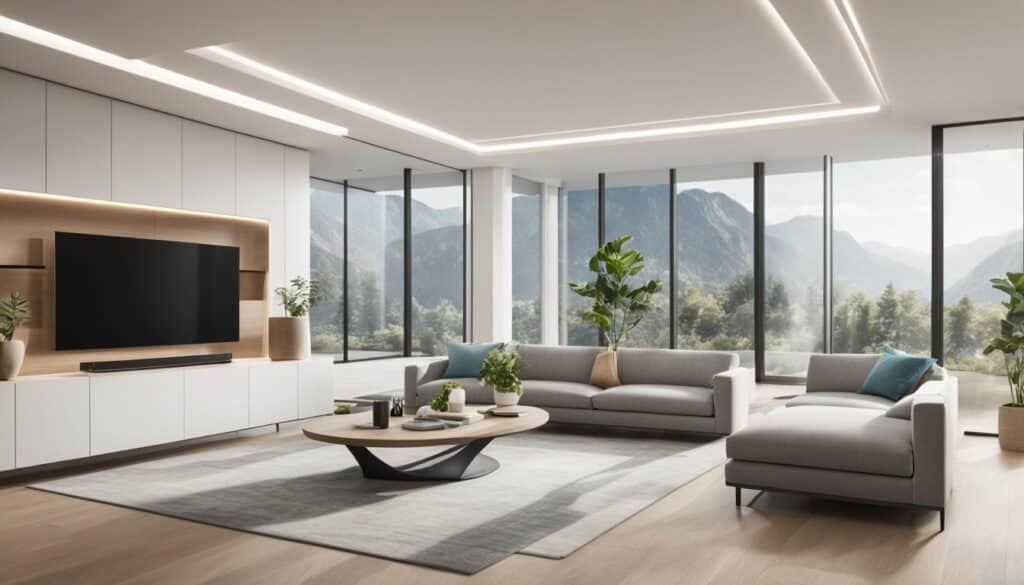
VR Tools and Technologies in Residential Architecture
| Tool/Technology | Description |
|---|---|
| VR Headsets | Delivers immersive experiences, allowing users to explore virtual environments and visualize architectural designs. |
| 3D Modeling Software | Enables architects and designers to create detailed virtual models of residential buildings, facilitating design visualization. |
| Architectural Visualization Platforms | Provides clients with real-time interaction in virtual spaces, allowing for an in-depth exploration of architectural designs. |
VR tools and technologies in residential architecture have revolutionized the design process, offering architects, designers, and clients new possibilities for collaboration and decision-making. These tools enhance the visualization and communication of architectural concepts, resulting in more efficient and satisfying design experiences.
Applications of VR in Residential Architecture
Virtual reality (VR) has revolutionized the way architects and designers approach residential architecture. With its immersive capabilities, VR opens up a world of possibilities when it comes to visualizing and exploring different design options. Here are some key applications of VR in the field of residential architecture:
Interior Design Visualization
VR technology allows clients to step into their future homes and experience them in a realistic manner. Through VR headsets, clients can virtually walk through the space, exploring different layout and decor options. This enables them to make informed decisions about room arrangements, color schemes, and furniture choices, ensuring the final design meets their expectations.
Urban Planning Simulations
VR is not limited to individual homes; it can also be utilized for urban planning purposes. Architects can create virtual simulations of entire neighborhoods or cities, providing stakeholders with a comprehensive view of proposed developments. This allows for better urban design decisions and helps assess the impact of new buildings or infrastructures on the surrounding environment.
Designing Sustainable Buildings
When it comes to designing sustainable and energy-efficient buildings, VR proves to be a valuable tool. Architects can simulate lighting conditions, airflow patterns, and other environmental factors to optimize energy usage and enhance sustainability. These simulations enable architects to make more informed design choices that prioritize energy efficiency and reduce the building’s environmental footprint.
By leveraging VR technology, architects and designers can create immersive and realistic experiences that empower clients to make well-informed decisions about their future homes. Whether it’s visualizing interior design options, simulating urban environments, or designing sustainable buildings, VR is revolutionizing the field of residential architecture.
| Application | Description |
|---|---|
| Interior Design Visualization | Allows clients to virtually experience and explore different layout and decor options. |
| Urban Planning Simulations | Enables architects to create virtual simulations of neighborhoods or cities to evaluate proposed developments. |
| Designing Sustainable Buildings | Uses VR to simulate lighting, airflow, and other environmental factors to optimize energy efficiency. |
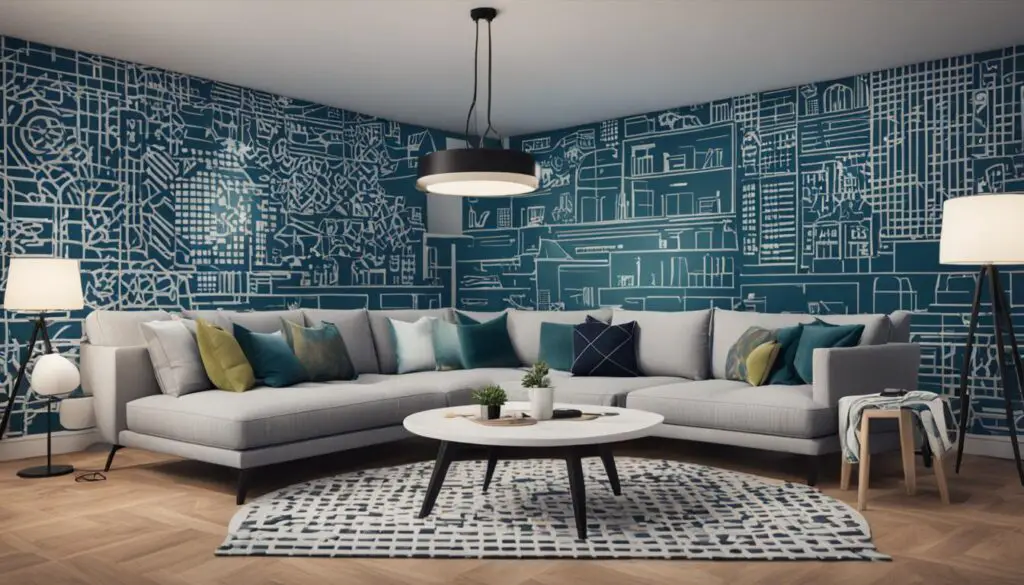
VR and Customization in Residential Architecture
VR technology is revolutionizing the way we customize residential architecture. With the advancements in virtual reality, clients now have the opportunity to personalize their homes like never before. Through virtual exploration, they can immerse themselves in different design options, experiment with materials, and play with layouts and decorations.
As an architect, VR enables me to effortlessly make changes and modifications based on client preferences. By incorporating their input into the virtual model, I can create personalized and tailor-made designs that align perfectly with their vision and needs.
“The level of customization we can achieve through VR is exceptional. It allows us to exceed client expectations and deliver truly unique and satisfying living spaces.”
This level of customization enhances the overall client experience and satisfaction. It gives them the power to actively participate in the design process, making their dream home a reality. With VR, clients no longer need to rely solely on their imagination or two-dimensional floor plans – they can now step inside their future homes and witness every detail come to life.
Benefits of VR and Customization in Residential Architecture
Let’s take a closer look at the benefits that VR-enabled customization brings to residential architecture:
- Enhanced Visualization: VR allows clients to see their dream home in a realistic and immersive way, providing a better understanding of the design concept.
- Design Validation: By virtually exploring different design options, clients can make informed decisions about layout, materials, and finishes, avoiding any regrets or costly changes later on.
- Improved Communication: VR bridges the gap between architects and clients, fostering clearer and more effective collaboration. Clients can easily communicate their preferences and architects can better understand and implement their ideas.
- Time and Cost Savings: With VR, the design process becomes more streamlined and efficient, minimizing the need for physical prototypes and reducing iterations and revisions.
- Inspiration and Creativity: VR opens up a world of possibilities, inspiring clients to be more creative in their customization choices and allowing architects to push the boundaries of design.
By harnessing the power of VR and customization, we create homes that are truly one-of-a-kind, reflecting the unique personalities and lifestyles of our clients.
VR and Customization in Action
Let’s delve into a real-life example of how VR-enabled customization transformed a residential architecture project:
| Project: Lakeview Residence | Location: Chicago, Illinois |
|---|---|
|
The Lakeview Residence project was brought to life using VR technology. The clients, a young couple, had a clear vision for their dream home but struggled to visualize how it would come together. By immersing themselves in the virtual model, they were able to confidently select the perfect finishes, experiment with different furniture layouts, and even adjust the ceiling heights to create the perfect ambiance. Thanks to the customized VR experience, the Lakeview Residence seamlessly combined the clients’ personal taste and preferences with innovative design solutions, resulting in a breathtaking home that exceeded their expectations. |
VR and customization are reshaping the landscape of residential architecture, elevating the client experience and pushing the boundaries of design. As technology continues to evolve, the possibilities for customization in architecture are limitless, giving us the ability to create homes that are not only functional, but also deeply personal and inspiring.
The Future of VR in Residential Architecture
The future of residential architecture is being shaped by the rapid advancement of virtual reality (VR) technology. As technology continues to evolve, VR experiences will become even more immersive, realistic, and accessible, revolutionizing the way we design and build homes.
Advancements in hardware and software will make VR tools and technologies more user-friendly and affordable, allowing for wider adoption in the industry. Architects and designers will have access to more powerful VR headsets and improved 3D modeling software, enabling them to create highly detailed virtual models of residential spaces.
“VR technology has the potential to completely transform the way we envision and experience residential architecture,” says Jane Thompson, an architect and VR enthusiast. “It allows us to step into a virtual world, walk through virtual rooms, and interact with virtual environments. This level of immersion gives us a deeper understanding of how a design will look and feel in real life.”
The future of VR in residential architecture goes beyond just design visualization. The integration of VR with other emerging technologies, such as augmented reality (AR) and artificial intelligence (AI), will further enhance the design and construction process. AR can overlay virtual elements onto the real world, allowing architects to see how a design fits into the existing environment. AI can analyze data and generate design suggestions based on user preferences and constraints.
With VR, architects will be able to collaborate more effectively with clients, contractors, and other stakeholders. They can host virtual design reviews and walkthroughs, allowing everyone involved to provide feedback and make informed decisions. This streamlined communication process will save time and reduce misinterpretations, leading to improved project outcomes.
As VR technology continues to evolve, it will also become more accessible to homeowners. VR tours of real estate listings can make the home-buying process more efficient by allowing potential buyers to virtually explore properties without physically visiting them. This will open up new opportunities for remote viewing and international real estate markets.
| Benefits of VR in Residential Architecture | Applications of VR in Residential Architecture |
|---|---|
|
|
The future of VR in residential architecture is full of possibilities. It has the potential to transform the way we design, experience, and interact with our homes. As technology continues to advance, VR will play a vital role in shaping the future of residential architecture, creating innovative and personalized living spaces.
Challenges and Considerations for VR in Residential Architecture
While VR technology offers numerous benefits for residential architecture, there are also specific challenges and considerations that architects and designers need to address. These factors play a crucial role in the successful integration of VR into the design process and the overall effectiveness of its implementation.
Cost and Complexity
One of the major challenges faced when implementing VR technology in residential architecture is the cost and complexity involved. VR requires specialized hardware and software, which can be expensive for both architects and clients. Additionally, the integration of VR into existing design workflows may require additional training and expertise, increasing the complexity of the process.
Collaboration and Social Interaction
While VR can provide an immersive experience for individual users, it can also be a solitary experience that limits collaboration and social interaction. In traditional design processes, architects often work closely with clients and collaborate with other professionals. It is important for architects and designers to find a balance between the virtual and physical aspects of the design process, ensuring that collaboration and social interaction are not compromised.
“The integration of VR into residential architecture should enhance collaboration and communication, rather than isolating individuals.”
Data Accuracy and Realism
Another consideration for VR in residential architecture is the accuracy and realism of the virtual environments. It is crucial for architects to ensure that the virtual representations are as close to reality as possible. This includes accurate dimensions, textures, lighting, and other visual elements. Any discrepancies or inaccuracies in the virtual environment may lead to design flaws or misconceptions about the final built space.
Adoption and Acceptance
As with any emerging technology, the adoption and acceptance of VR in residential architecture can be a challenge. Some clients may be skeptical of the benefits or may have limited exposure to VR technology. Architects and designers need to educate clients about the advantages of VR and demonstrate its value in the design process. Building trust and confidence in the technology can help overcome any resistance or hesitation.
Privacy and Security
Residential architecture involves personal and private information about individuals and their homes. Therefore, architects need to take privacy and security considerations into account when using VR technology. Any data collected or stored during the VR design process should be handled securely and in compliance with privacy regulations.
Challenges and Considerations for VR in Residential Architecture
| Challenges | Considerations |
|---|---|
| Cost and Complexity | Implementing specialized hardware and software |
| Collaboration and Social Interaction | Balancing virtual and physical aspects of the design process |
| Data Accuracy and Realism | Ensuring accurate virtual representations |
| Adoption and Acceptance | Educating clients about the benefits and value of VR |
| Privacy and Security | Protecting personal information and complying with privacy regulations |
Addressing these challenges and considerations is crucial for architects and designers to fully leverage the potential of VR technology in residential architecture. By carefully navigating these aspects, VR can enhance the design process, improve client collaboration, and ultimately result in more innovative and satisfying residential spaces.
Conclusion
VR technology is revolutionizing the future of residential architecture, transforming the design and visualization process. Its numerous benefits include improved client communication, enhanced customization options, and substantial time and cost savings. While there are challenges to overcome, the potential for VR in residential architecture is vast, and it will continue to play an increasingly significant role in shaping the way we envision and experience living spaces in the future.
With VR, architects and designers can now create realistic virtual environments, allowing clients to fully visualize and experience the design before it is built. This immersive and interactive experience helps identify any design flaws or improvements early on, ensuring a smoother and more efficient construction process.
Furthermore, VR technology empowers clients to personalize their homes by exploring different design options, choosing materials, and experimenting with layouts and decor. Architects can easily make changes and modifications based on client preferences, resulting in more tailored and satisfying designs.
FAQ
What is VR technology and how is it used in residential architecture?
VR technology allows architects and designers to create realistic virtual environments and present their ideas in an immersive and interactive way. It is used in residential architecture to visualize and experience designs before they are built, identify design flaws or improvements, and provide clients with a more realistic understanding of the design concept.
What are the benefits of using VR in residential architecture?
VR offers several benefits in residential architecture. It allows architects and clients to visualize and experience designs before they are built, helping to identify potential design flaws early on. VR also provides a more immersive and realistic experience, enabling clients to fully understand and appreciate the design concept. Additionally, VR can save time and cost by eliminating the need for physical prototypes and allowing for quick design iterations.
What are the VR tools and technologies used in residential architecture?
VR tools and technologies used in residential architecture include VR headsets, 3D modeling software, and architectural visualization platforms. VR headsets provide an immersive experience, allowing users to explore and interact with virtual environments. 3D modeling software helps architects and designers create detailed virtual models of the building, while architectural visualization platforms enable clients to view and interact with these models in real-time.
How is VR applied in residential architecture?
VR has various applications in residential architecture. It can be used for interior design, allowing clients to virtually walk through the space and visualize different layout and decor options. VR can also be utilized for urban planning, enabling architects to create virtual simulations of entire neighborhoods or cities to assess the impact of new developments. Additionally, VR can assist in the design of sustainable and energy-efficient buildings by simulating lighting, airflow, and other environmental factors.
How does VR enhance customization in residential architecture?
VR technology enables a new level of customization in residential architecture. Clients can virtually explore different design options, choose materials, and experiment with layout and decor to personalize their homes. VR also allows architects to easily make changes and modifications based on client preferences, leading to more personalized and tailor-made designs, enhancing the overall client experience and satisfaction.
What does the future hold for VR in residential architecture?
The future of VR in residential architecture looks promising. As technology continues to evolve, VR experiences will become even more immersive, realistic, and accessible. Advancements in hardware and software will make VR tools and technologies more user-friendly and affordable, allowing for wider adoption in the industry. The integration of VR with other emerging technologies, such as augmented reality and artificial intelligence, will further enhance the design and construction process.
What are the challenges and considerations for using VR in residential architecture?
One major challenge is the cost and complexity of implementing VR technology in the design process. VR requires specialized hardware and software, which can be expensive and may require additional training for architects and designers. Another consideration is the potential for VR to be a solitary experience, limiting collaboration and social interaction. It is important for architects to find a balance between the virtual and physical aspects of the design process.
How is VR transforming the future of residential architecture?
VR technology is revolutionizing the future of residential architecture by transforming the design and visualization process. It offers numerous benefits, including improved client communication, enhanced customization, and time and cost savings. While there are challenges to overcome, the potential for VR in residential architecture is vast. As technology continues to advance, VR will play an increasingly significant role in shaping the way we envision and experience living spaces in the future.



